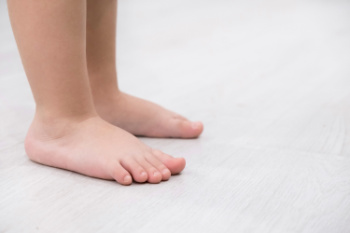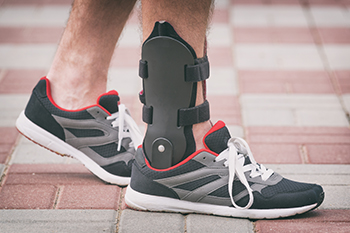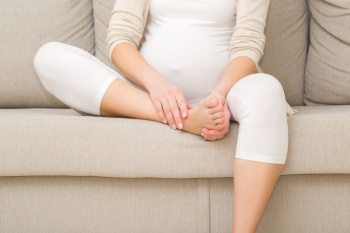Blog
Items filtered by date: January 2025
Flat Feet and Pronation in Children

Flat feet, also known as fallen arches, is a condition where the arch of the foot does not develop properly, causing the entire sole to touch the ground. This condition is common in young children as their arches may not yet be fully formed. Flat feet can be associated with different types of pronation, which refers to the way the foot rolls inward during walking or running. Normal pronation occurs when the foot rolls slightly inward to absorb shock. Under-pronation, or supination, happens when the foot does not roll inward enough, leading to less shock absorption. Over-pronation occurs when the foot rolls inward too much, which can cause stress on the joints and lead to pain. Symptoms of flat feet in children may include foot pain, swelling, difficulty walking, or an unusual gait. If your child is experiencing foot pain from having flat feet, it is suggested that you consult a podiatrist who can offer relief tips and monitor your child’s foot health.
Flatfoot is a condition many people suffer from. If you have flat feet, contact Stephanie Tine, DPM from Flamingo Foot and Ankle. Our doctor will treat your foot and ankle needs.
What Are Flat Feet?
Flatfoot is a condition in which the arch of the foot is depressed and the sole of the foot is almost completely in contact with the ground. About 20-30% of the population generally has flat feet because their arches never formed during growth.
Conditions & Problems:
Having flat feet makes it difficult to run or walk because of the stress placed on the ankles.
Alignment – The general alignment of your legs can be disrupted, because the ankles move inward which can cause major discomfort.
Knees – If you have complications with your knees, flat feet can be a contributor to arthritis in that area.
Symptoms
- Pain around the heel or arch area
- Trouble standing on the tip toe
- Swelling around the inside of the ankle
- Flat look to one or both feet
- Having your shoes feel uneven when worn
Treatment
If you are experiencing pain and stress on the foot you may weaken the posterior tibial tendon, which runs around the inside of the ankle.
If you have any questions please feel free to contact our office located in Fort Lauderdale, FL . We offer the newest diagnostic and treatment technologies for all your foot and ankle needs.
Keep Your Feet Healthy So You Can Stay Active
Good Foot Care for Diabetic Patients

For individuals with diabetes, proper foot care is crucial to prevent complications that can arise due to poor circulation and nerve damage. Diabetic patients should inspect their feet regularly for any signs of trouble, such as cuts, blisters, or sores, as these can quickly develop into more serious infections. Loss of feeling, known as neuropathy, is common in people who have diabetes and can make it difficult to notice injuries or infections. Changes in the shape of the feet or toes, such as swelling or the development of bunions, can also signal potential issues that need attention. Foot pain, whether constant or occasional, should not be ignored, as it could indicate an underlying problem like arthritis or poor circulation. Wearing well-fitting shoes and keeping the feet clean and moisturized can help prevent many foot issues. If you have diabetes, it is suggested that you are under the care of a podiatrist who can help you to manage this serious condition.
Diabetic foot care is important in preventing foot ailments such as ulcers. If you are suffering from diabetes or have any other concerns about your feet, contact Stephanie Tine, DPM from Flamingo Foot and Ankle. Our doctor can provide the care you need to keep you pain-free and on your feet.
Diabetic Foot Care
Diabetes affects millions of people every year. The condition can damage blood vessels in many parts of the body, especially the feet. Because of this, taking care of your feet is essential if you have diabetes, and having a podiatrist help monitor your foot health is highly recommended.
The Importance of Caring for Your Feet
- Routinely inspect your feet for bruises or sores.
- Wear socks that fit your feet comfortably.
- Wear comfortable shoes that provide adequate support.
Patients with diabetes should have their doctor monitor their blood levels, as blood sugar levels play such a huge role in diabetic care. Monitoring these levels on a regular basis is highly advised.
It is always best to inform your healthcare professional of any concerns you may have regarding your feet, especially for diabetic patients. Early treatment and routine foot examinations are keys to maintaining proper health, especially because severe complications can arise if proper treatment is not applied.
If you have any questions please feel free to contact our office located in Fort Lauderdale, FL . We offer the newest diagnostic and treatment technologies for all your foot and ankle needs.
Benefits of Wearing an Ankle Brace

Ankle braces are a valuable tool for protecting and supporting the foot and ankle, whether preventing injuries or aiding recovery from sprains or ligament damage. Ankle braces help stabilize the joint, reducing excessive movement that could lead to further strain or injury. People with weak ankles or those prone to sprains often benefit from wearing braces during activities that put stress on the ankle. These braces can also help reduce swelling and discomfort by supporting the tendons and ligaments as they heal. There are many types of braces, including pull-on and lace-up designs, with some featuring rigid supports for enhanced stability. A poorly fitting brace may not provide adequate support, which is why consulting a podiatrist is important. This type of doctor can evaluate your injury, recommend the most suitable type of brace, and ensure it fits properly to promote healing and prevent future issues. If you have sustained an ankle injury, it is suggested that you schedule an appointment with a podiatrist for a diagnosis to determine if a brace is needed.
Ankle pain can be caused by a number of problems and may be potentially serious. If you have ankle pain, consult with Stephanie Tine, DPM from Flamingo Foot and Ankle. Our doctor will assess your condition and provide you with quality foot and ankle treatment.
Ankle pain is any condition that causes pain in the ankle. Due to the fact that the ankle consists of tendons, muscles, bones, and ligaments, ankle pain can come from a number of different conditions.
Causes
The most common causes of ankle pain include:
- Types of arthritis (rheumatoid, osteoarthritis, and gout)
- Ankle sprains
- Broken ankles
- Achilles tendonitis
- Achilles tendon rupture
- Stress fractures
- Bursitis
- Tarsal tunnel syndrome
- Plantar fasciitis
Symptoms
Symptoms of ankle injury vary based upon the condition. Pain may include general pain and discomfort, swelling, aching, redness, bruising, burning or stabbing sensations, and/or loss of sensation.
Diagnosis
Due to the wide variety of potential causes of ankle pain, podiatrists will utilize a number of different methods to properly diagnose ankle pain. This can include asking for personal and family medical histories and of any recent injuries. Further diagnosis may include sensation tests, a physical examination, and potentially x-rays or other imaging tests.
Treatment
Just as the range of causes varies widely, so do treatments. Some more common treatments are rest, ice packs, keeping pressure off the foot, orthotics and braces, medication for inflammation and pain, and surgery.
If you have any questions, please feel free to contact our office located in Fort Lauderdale, FL . We offer the newest diagnostic and treatment technologies for all your foot care needs.
Causes of Swollen Feet During Pregnancy

Foot swelling, also known as edema, is common during pregnancy. The feet swell as the body retains extra fluid to support the mother and growing baby. As the uterus expands, it can put pressure on the veins, reducing circulation in the lower legs and feet. Hormonal changes can also contribute to water retention. While the swelling is generally harmless, it can be uncomfortable. To find relief, pregnant women should elevate their feet whenever possible to encourage fluid drainage. Wearing comfortable shoes, staying hydrated, and avoiding standing or sitting for long periods can help reduce swelling. Gentle foot exercises and compression stockings may also provide comfort and promote better circulation during pregnancy. If your feet have become swollen during your pregnancy, it is suggested that you consult a podiatrist who can help you find relief.
Pregnant women with swollen feet can be treated with a variety of different methods that are readily available. For more information about other cures for swollen feet during pregnancy, consult with Stephanie Tine, DPM from Flamingo Foot and Ankle. Our doctor will attend to all of your foot and ankle needs.
What Foot Problems Can Arise During Pregnancy?
One problem that can occur is overpronation, which occurs when the arch of the foot flattens and tends to roll inward. This can cause pain and discomfort in your heels while you’re walking or even just standing up, trying to support your baby.
Another problem is edema, or swelling in the extremities. This often affects the feet during pregnancy but tends to occur in the later stages.
How Can I Keep My Feet Healthy During Pregnancy?
- Wearing orthotics can provide extra support for the feet and help distribute weight evenly
- Minimize the amount of time spent walking barefoot
- Wear shoes with good arch support
- Wear shoes that allow for good circulation to the feet
- Elevate feet if you experience swelling
- Massage your feet
- Get regular, light exercise, such as walking, to promote blood circulation to the feet
If you have any questions please feel free to contact our office located in Fort Lauderdale, FL . We offer the newest diagnostic and treatment technologies for all your foot and ankle needs.
Blog Archives
- April 2025
- March 2025
- February 2025
- January 2025
- December 2024
- November 2024
- October 2024
- September 2024
- August 2024
- July 2024
- June 2024
- May 2024
- April 2024
- March 2024
- February 2024
- January 2024
- December 2023
- November 2023
- October 2023
- September 2023
- August 2023
- July 2023
- June 2023
- May 2023
- April 2023
- March 2023
- February 2023
- January 2023
- December 2022
- November 2022
